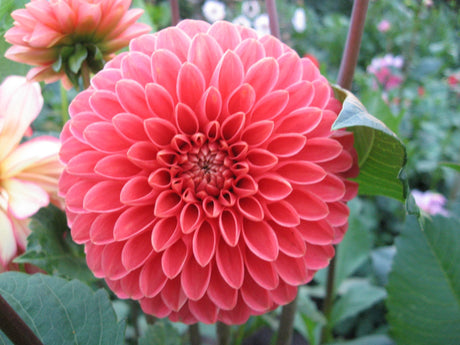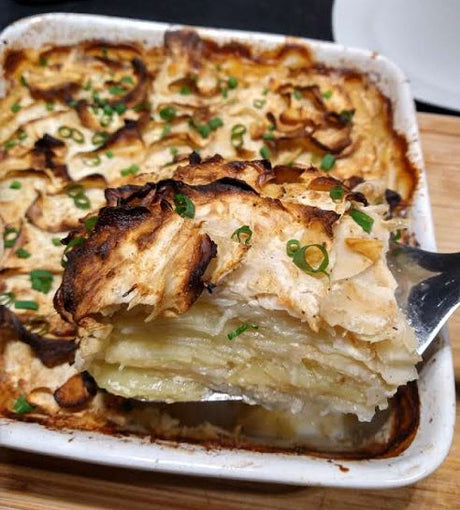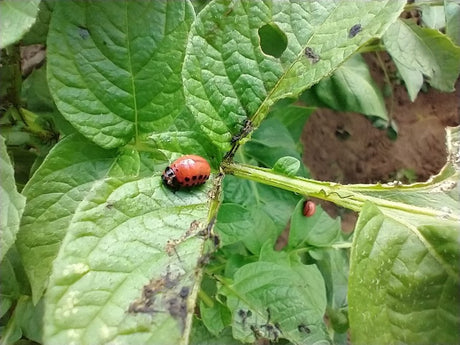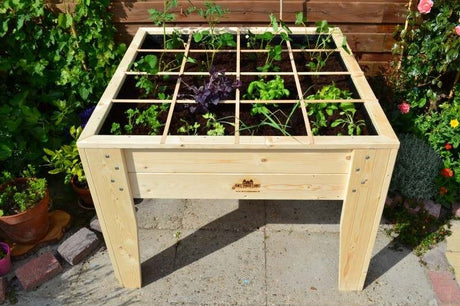Quick start ⚡ Quick start info for growing potatoes ⚡
🌱 Sowing & planting
- Sowing depth: Potatoes are usually planted at 8–15 cm (about twice the height of the potato)
- Sowing distance: n/a
- Germination: n/a
- Planting distance: Early varieties: 30 cm between plants and 50 cm between rows; later varieties: 50 cm between plants and 70 cm between rows
- Planting out: n/a
- Growth cycle: 90 to 120 days after planting out
📅 Growing times throughout the year
- Preparing seed potatoes: Place the seed potatoes on the windowsill a few weeks before planting so that they germinate and have a head start.
- Early varieties: Plant outdoors from early March to early April; harvest from mid-June to early July.
- Mid-early varieties: Plant outdoors from mid-March to late April; harvest in August.
- Mid-late varieties: Plant outdoors in April; harvest in September.
- Late varieties: Plant outdoors from April to mid-May; harvest from mid-October to early November.
📘 Basic information
- Crop group: other
- Crop family: nightshade family
- Height: 30–75 cm
- Growth cycle: 90 to 120 days after planting out
- Frost resistant: little
- Root depth: 45–60 cm
- Preferred soil: pH 4.5–6.0, rich soil (compost) with good drainage
- Fertilization: two applications of patent potash: the first at planting, the second after earthing up. Potatoes are potash hogs; potash produces stronger plants, a higher yield, and prevents bruising caused by impact, among other things.
🌞💧 Pitch & water
- Location: 🌞 Lots of sun
- Water requirement: 💧💧💧 Lots of water
🤝 Good & Bad Neighbors
✅ Good neighbors
- Marigold
- Garlic
- Cabbage
- Kohlrabi
- Corn
- Nasturtium
- Coin
- Broad bean
- Sunflower
❌ Bad neighbors
- Cucumber
- Pumpkin
- Celery
- Tomato
❗ Dangers & Concerns
- Common problem: Potato blight.
🧺 Harvesting & storing
Potatoes are ready for harvest when the foliage is brown and withered.
Using a shovel, pitchfork, or spade, loosen the soil around the potatoes and pick up the tubers.
🍽️ Nutritional value of potatoes
- 100 g boiled potato (without skin, without salt) contains approximately:
- 86 kcal
- 0 g fat
- 20 g carbohydrates
- 2 g protein
- 2 g fiber
- 3 g sugar
- Vitamins: B6 and C
- Minerals: potassium
Table of Contents:
Gathering potatoes with the whole family a few times a year... it almost feels like a ritual to me. As soon as the potato fork or spading fork lifts a clump of earth and reveals beautiful, plump potatoes underneath, euphoria sets in. The children cheer with joy, as if they've discovered a hidden treasure. Because they also help plant the seed potatoes , they learn a valuable lesson: what you pay attention to, grows! The flavor of our own organically grown potatoes is so intense and rich that we always watch with a touch of nostalgia as the last crate empties. Buying potatoes again after that? That's still a bit of a bitter pill to swallow.
Did you know there's a difference between a regular potato and, for example, a sweet potato? A regular potato is a true potato and comes from the Solanum tuberosum plant, while a sweet potato comes from a different plant family and is therefore not a true potato.
Growing potatoes isn't difficult at all. Proper soil preparation will get you a long way. Growing your own potatoes is truly worthwhile: you'll enjoy the best flavor and the pleasure of your own harvest, even if it takes some effort. The information in this article applies to all potato varieties.
When to plant potatoes:
- Early potatoes : Plant outdoors from early March to early April; harvest from mid-June to early July.
- Mid-early potatoes : Plant outdoors from mid-March to late April; harvest in August.
- Mid-late potatoes : Plant outdoors in April; harvest in September.
- Late potatoes : Plant outdoors from April to mid-May; harvest from mid-October to early November.

Quick start info for growing potatoes
General information
- Latin name : Solanum tuberosum
- Crop group : other
- Family : nightshade family ( Solanaceae )
Cultivation information
- How deep to plant potatoes : 8-15 cm (about twice the height of the seed potato)
- Plant height : 30-75 cm
- Planting distance : Early varieties: 30 cm between plants, 50 cm between rows. Later varieties: 50 cm between plants, 70 cm between rows.
- Growth cycle : 70-120 days after planting
For a good start, let the seed potatoes germinate on a windowsill for a few weeks before planting them out. Place the potatoes with the mini-sprouts facing up. Boxes or egg trays are ideal for planting them. Check our product pages for the best time to plant them out.
- Early cultivation : plant potatoes between early March and early April, harvest from mid-June to early July
- Mid-late cultivation : plant potatoes in April, harvest in August/September
- Late cultivation : plant potatoes between April and mid-May, harvest from mid-October to early November
Growing conditions
- Location : lots of sun
- Water requirement : high
- Good neighbors : marigold, garlic, cabbage, kohlrabi, corn, nasturtium, mint, broad bean, sunflower
- Bad neighbors : cucumber, pumpkin, celery, tomato
- Frost resistance : slightly frost sensitive
- Root depth : 45-60 cm
- Soil requirements : pH 4.5-6.0, rich soil with compost, good drainage
Fertilization
Potatoes are real potassium or potash hogs. Adding potash twice (organically permitted) is a must:
- First gift : when planting
- Second gift : after earthing up
This ensures stronger plants, a higher yield and less susceptibility to diseases.
Dangers and diseases
- Potato blight (Phytophthora)
- Colorado beetle
- Wire needles
Harvesting & Storage
Potatoes are ready for harvest when the foliage is brown and withered. The foliage often turns yellow, a clear sign that the potatoes are ready to be harvested. Use a potato rake, pitchfork, shovel, or spade to gently loosen the soil and dig out the potatoes.
Nutritional value (per 100 grams of boiled potato without peel and salt)
- Energy : 86 kcal
- Fat : 0 g
- Carbohydrates : 20 g
- Protein : 2 g
- Fiber : 2 g
- Sugar : 3 g
- Vitamins : B6, C
- Minerals : Potassium











